We sincerely hope that you enjoy this article about 6 Marine Apex Predators. The sea has long held a deep fascination for many people, and that holds true for its denizens as well. Even among its countless inhabitants, though, one group stands out.
The predators of the oceans and seas seem to fascinate and amaze us more than any others. Obviously, these 6 Marine Apex Predators only represent some of the mighty hunters of the deeps. But, we feel that they do remain among the mightiest of the mighty.
Leopard Seal Facts
- First up among our choices for inclusion in this article about 6 Marine Apex Predators is the amazing Leopard Seal.
- First of all, don’t let the seemingly gentle appearance of the remarkable animal fool you. This appearance remains nothing but an illusion. This truly amazing animal actually ranks as the second leading predator in all of Antarctica.
- This truly magnificent work of Nature also goes by the somewhat tongue-twisting scientific name of the Hydrurga leptonyx. The fantastic marine animal draws its name from specific physical characteristics that it displays.
- These remarkable attributes consist of the presence of numerous spots on its deceptively powerful body. In addition to this, the astounding ocean-dwelling creature also represents the second largest species of seal in the Antarctic.
- The species is also known for its unpredictable mood swings. It’s able to switch from playfully curious behavior to dangerous aggression without warning. Though not generally threatening to humans, individuals have been known to attack divers.
Leopard Sea Physical Description
The Leopard Seal also evolved as both large and powerful. This makes for a dangerous combination. A rather slight degree of sexual dimorphism also presents itself in this animal. But, in this case, the females are generally slightly larger in size than the males.
The animal commonly attains a length of as much as 11.5 ft (3.5 m). Not only that, these amazingly impressive animals weigh up to 1,320 lb (600 kg). In addition to the omnipresent spots, the seal is a light gray in color on the stomach and a darker gray on the back.
The front teeth of this powerful carnivore remain razor sharp. Yet another interesting adaptation of the Leopard Seal regards its teeth. Nature locks the molars together in a way that allows the animal to filter krill from the water when larger prey is unavailable.
- Kingdom: Animalia
- Phylum: Chordata
- Class: Mammalia
- Order: Carnivora
- Family: Phocidae
- Genus: Hydrurga
- Species: H. leptonyx
Leopard Sea Distribution, Habitat, and Ecology
The beautiful bet deadly Leopard Seal inhabits a particularly inhospitable part of the world. That holds true due to the fact that it lives exclusively in the extremely cold waters of Antarctica. But, it will migrate within that overall region.
Individuals divide their time between the ice packs and the upper portions of the ocean, never diving very deep. The fabulous and powerful seals also live a primarily solitary life. The sole exception to this appears to occur during mating season.
At this time, which occurs during the spring and summer, many individuals further spend long periods of time underwater, vocalizing. This continues to be believed to be part of the mating ritual. After mating, the female gives birth to a single pup.
The Leopard Seal also evolved as a predator. This powerful creature hunts comparatively large prey, in relation to its body size. But, it also feeds opportunistically. The prey most commonly includes various species of penguins, squid, fish, and even other species of seals.
Giant Trevally
Giant Trevally Facts
- The next species appearing on this listing of 6 Marine Apex Predators is one many of you may not know of, the Giant Trevally.
- Perhaps most notably, one fact truly stands out from the others about the amazing species. That’s the relatively surprising fact that the impressive creature actually constitutes an apex predator in most of the regions it inhabits.
- The highly distinctive species holds this impressive status due to a combination of several fascinating factors. Firstly, in one part of its native habitat range, this fascinating fish has developed a remarkable behavioral trait.
- This holds true because the wonder of Nature frequently shadows the movements of certain seals. By doing this, the resourceful fish often catches prey preoccupied with escaping the seals. It literally lets the seals do its work for it.
- Secondly, the fish does not simply play it safe. In fact, this species also sometimes employs the same technique with various sharks. The amazing animal utilizes this highly evolved strategy both singly and working in groups, in coordination.
- Finally, it shows itself to have an incredible ability. Individuals in one specific part of its range use the most remarkable strategy of all. There, many individuals of the Giant Trevally prey on young terns, as they fall into the water while learning to fly.
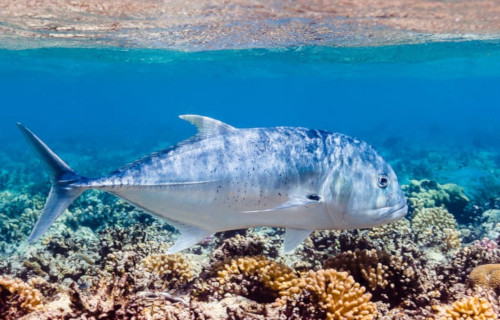
CCL: https://bit.ly/1iowB8m
Giant Trevally Physical Description
Quite clearly, the Giant Trevally lives up to the most often used common name. That holds true because the fascinating creature ranks as the largest species in its genus. Most related species remain much smaller in terms of length and weight.
Most notably, rare individuals sometimes measure up to as much as a truly astonishing 5.57 ft (1.7 m) in length. Some specimens also weigh as much as an astounding 176 lb (80 kg). Most individuals, however, rarely exceed lengths of more than 31.5 in (80 cm).
The body of this animal also typically has an impressively elongated shape. It also displays an ovate body, with a marginally compressed form. These facts, therefore, make the overall appearance of the creature remarkably similar to related species.
But, unlike some species, the Giant Trevally does not display any degree of sexual dimorphism. In both genders, the coloring is a silvery-gray. Yet older individuals often turn almost completely black. The upper body and head often appear darker in both sexes.
- Kingdom: Animalia
- Phylum: Chordata
- Class: Actinopterygii
- Order: Perciformes
- Family: Carangidae
- Genus: Caranx
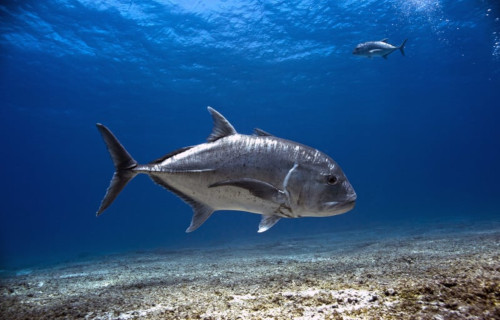
CCL: https://bit.ly/1eBd9Ks
Giant Trevally Distribution, Habitat, and Ecology
Quite fortunately, the marvelous Giant Trevally has a comparatively wide distribution range. To be more precise, it inhabits specific sections of both the Pacific and Indian Oceans. This substantial range further extends along the coasts of three continents.
But within than range, this impressive species only inhabits tropical and subtropical waters. However, that area also includes hundreds of islands and archipelagos of all sizes. Some of these even include Madagascar and the Maldives.
Its versatility, though, is not merely limited to its geographical range. That’s because it also thrives in a wide range of both inshore and offshore marine environments. The awesome Giant Trevally even sometimes appears in places like estuaries and rivers.
Finally, its feeding patterns understandably vary from region to region, and its diet does also. But, the majority of its prey includes fish, cephalopods, crustaceans, mollusks. Yet, its appetite even extends to birds in one part of its range.
Great White Shark
Great White Shark Facts
- Placing third in this compendium of 6 Marine Apex Predators, the magnificent Great White Shark does so only due to random selection.
- The commonly used term perfectly serves as one of the common names for a truly incredible variety of mackerel shark. This marvel of Nature also goes by the other common names, though, such as the great white, the white shark, and white pointer.
- In the meantime, it also has the tongue-twisting scientific name of the Carcharodon carcharias. But, regardless of what name one uses to refer to it, this magnficent creature represents one of the oceans primary apex predators.
- This incredibly efficient hunter also has almost no known predators of its own. This holds true throughout the entirety of its natural range. The rare exception, though, would be rare attacks by orcas when other, easier prey cannot be found.
- The breathtaking Great White Shark also exemplifies a very fast and far-ranging hunter. This true marvel of Nature has the ability to reach speeds measuring as much as 35 mph (56 kph). It can also safely dive to depths of as much as 3,900 ft (1,200 m).
- For a variety of reasons, the IUCN lists this majestic creature as Vulnerable. This holds true largely due to such factors as habitat loss and reduction of its prey, due to human commercial fishing practices. However, it also faces danger from climate change.
Great White Shark Physical Description
The remarkably impressive Great White Shark earns this status for several reasons, one of them being its sheer physical size. That’s because it attains a maximum known length of 20 ft (6 m) and weighs as much as roughly 5,000 pounds (2,268 kg).
It displays a visually striking color pattern. This holds true due to the fact that, most commonly, it appears grayish in color on the top part of its body and white underneath. In addition, just like many species of sharks, the Great White Shark has multiple rows of teeth.
Like all sharks, it also possesses a special sensory organ which allows it to detect the electromagnetic fields generated by the movement of living animals. In this species, this sense seems to be rather especially acute, allowing it to detect a field of half a billionth volt.
- Kingdom: Animalia
- Phylum: Chordata
- Class: Chondrichthyes
- Order: Lamniformes
- Family: Lamnidae
- Genus: Carcharodon
- Species: C. carcharias
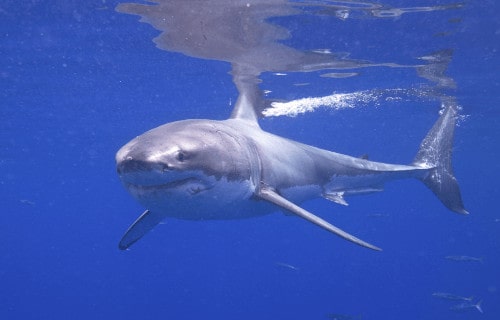
CCL: https://bit.ly/1ryPA8o
Great White Shark Distribution, Habitat, and Ecology
It bears mentioning that the remarkable Great White Shark has more advantages than just its physical attributes. That holds true because it possesses an almost global range of habitation. This gives it a decided advantage over many species.
As a result, this truly amazing fish inhabits virtually all temperate and tropical waters. This fact often amazes those who encounter it. But, the greatest known concentration of its numbers presently occurs in the waters off the coast of South Africa, in Africa.
The incredibly powerful predator most commonly appears in coastal and offshore areas. This practice, quite unfortunately, frequently leads to encounters with humans. There, though, it rarely, though not never, enters waters with depths of less than 1,000 ft (305 m).
This extremely dangerous creature much more commonly appears at great depths, however. These often reach as deep as 3,900 ft (1,200 m). Additionally, with an average lifespan of 25 – 30 years, it generally prefers to stalk a regular territory.
Given its power and speed, the supremely effective predator quite understandably feeds on a wide variety of prey. In point of fact, this monstrously powerful, and also highly aggressive, hunter will feed on virtually any creature it can find.
The Great White Shark nevertheless does tend to have certain preferences for its choice of prey, as nearly all creatures do. More specifically, these include tuna, dolphins, seals, sea turtles, sea otters, and even, when possible, marine birds.
Steller Sea Lion
Steller Sea Lion Facts
- Our fourth entry into this article concerning 6 Marine Apex Predators is the lovely but dangerous Steller Sea Lion.
- The term for this creature amply serves as one of the common names of a particularly impressive variety of mammal. This incredible wonder of evolution also goes by the alternate common name of the northern sea lion, though.
- Its scientific name remains that of the extremely difficult to pronounce term of the Eumetopias jubatus. Regardless of which name one chooses to use to refer to it, however, this animal ranks as the largest of all forms of eared seals.
- In point of fact, among the group known to researchers as pinnipeds, it ranks very near the top in terms of sheer physical seize. That’s true since only the walrus and 2 species of elephant seals grow to a larger size than this amazing animal.
- The species bears the common name that it does in honor of the first person to officially recognize the species. That was the well respected German botanist and zoologist, Georg Wilhelm Steller. This fortuitous description occurred in the year 1741.
- Quite sadly, and for reasons that remain undetermined, its numbers have decreased substantially in the past 30 years. This fact, most unfortunately, holds true throughout most of its range. Ongoing research continues to seek a reason, though.
- Numerous, though sadly, not all, countries have therefore banned the slaughter of these impressive marine creatures. Due to these facts, the IUCN currently lists this magnificent ocean creature as Near Threatened.
- The magnificent Steller Sea Lion thankfully now has protection via the Marine Mammal Protection Act in the United States, however. Fortunately for the fascinating species, that country controls the largest portion of its endemic range.
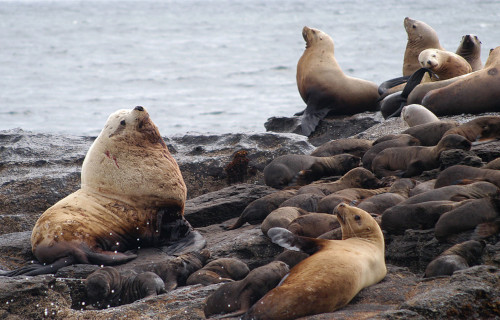
Photo: Oregon Department of Fish & Wildlife
CCL: https://bit.ly/3fVZDVt
Steller Sea Lion Physical Description
Like many related species, the Steller Sea Lion displays a pronounced degree of sexual dimorphism. Females grow until the fifth year, while the larger males grow until the eighth year. Males also typically grown slightly longer and heavier than females.
The males have a much broader and stockier build than that of the shorter females. Males also average roughly 10.7 ft (3.3 m) in length and weigh as much as 2,470 lb (1,120 kg). Females attain an average length of 9.5 ft (2.9 m), and a weight of up to 770 lb (350 kg).
Both genders of the Steller Sea Lion typically show a tawny or reddish color as adults. By contrast, the pups appear almost black. Adult males also tend to have a dark tuft of hair around the neck, consequently giving them the appearance of having a small mane of hair.
- Kingdom: Animalia
- Phylum: Chordata
- Class: Mammalia
- Order: Carnivora
- Family: Otariidae
- Genus: Eumetpoias
- Species: E. jubatus

Public Domain Image
Steller Sea Lion Distribution, Habitat, and Ecology
The magnificent Steller Sea Lion inhabits a moderately large portion of the globe. This remains the case, at least, when its range is compared to related species. That holds true partly due to the fact that it inhabits a decidedly northern territory range.
More precisely, though, this awesome wonder of Nature inhabits an area that begins in the vicinity of the Sea of Okhotsk. This territory then roughly extends to an island off the coast of northern California, in the United States, in North America.
These extremely powerful predators most commonly live in areas consisting of various coastal waters throughout their range. The impressive mammals also typically congregate in relatively large groups for mating and rearing the young.
This same process also usually takes place on the beaches of various remote islands. This tends to provide with a relative degree of safety. A single birth remains most common. Nevertheless, multiple births do happen occasionally as well.
As a very highly skilled marine predator, the Steller Sea Lion quite actively and aggressively hunts its prey. Individuals also generally feed on a wide range of prey. Yet, this does most typically consist of numerous mid-sized cephalopod and fish species.
Sometimes, however, individuals of this powerful predator prey on small species of seals. Understandably, its own natural predators remain few, given its size. But, it does occasionally fall victim to certain larger types of shark, as well as the Orca.
Orca
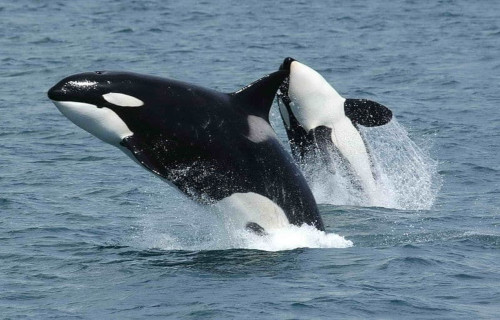
CCL: https://bit.ly/1eBd9Ks
Orca Facts
- Placing fifth among our choices for inclusion within this article about 6 Marine Apex Predators is the beautiful but deadly Orca.
- The simple term names an unforgettable species of toothed whale that many refer to the species as killer whales. This breathtakingly beautiful, but deadly, marvel of Nature also forms the largest extant species of the oceanic dolphin family.
- The powerful creature thus remains regarded as an apex predator in every ocean, much like the Great White Shark. Due to various reasons related to its movements, the IUCN currently lists its conservation status as Data Insufficient.
- That highly uncertain status appears on the organization’s Red List of Threatened Species. This also occurs because many scientists believe that the behavior of various local populations may indicate the existence of two or more subspecies of Orca.
- Nonetheless, many individuals currently believe this magnificent creature to be facing various threats to its continued existence. One of these perils continues to be that of becoming an accidental bycatch in commercial fishing.
- Another threat, however, remains the danger of encounters with boats. That holds true of both fishing and recreational forms. Its greatest threat, however, most likely comes from the ongoing effects of climate change.
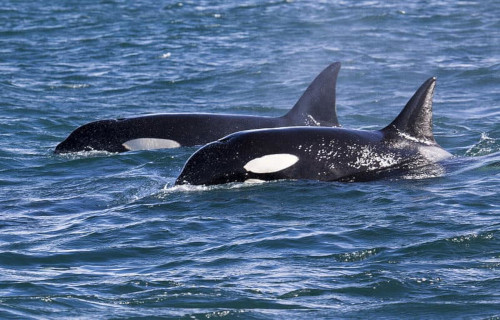
CCL: http://bit.ly/2RcCTlc
Orca Physical Description
Perhaps most notably, the adult Orca possesses a very distinctive color pattern. and is therefore rarely confused with any other creature, even at a distance. Typically, the animal presents black on the back with sides and chest a bright white in color.
This magnificent animal also displays a white patch present behind and above the eye. Its body shape is heavy and robust. A small degree of sexual dimorphism also exists. The male Orca averages between 20-26 ft (6-8 m) in length, and about 12,000 lb (5,443 kg) in weight.
Females, however, develop somewhat smaller than that in overall size. In point of fact, these reach maturity with an average length of 16-23 ft (5-7 m), and an average weight of 8,000 lb (3,629 kg). The dorsal fin of the male is also twice the size of that of the female.
- Kingdom: Animalia
- Phylum: Chordata
- Class: Mammalia
- Order: Artiodactyla
- Family: Delphinidae
- Genus: Orcinus
- Species: O. orca
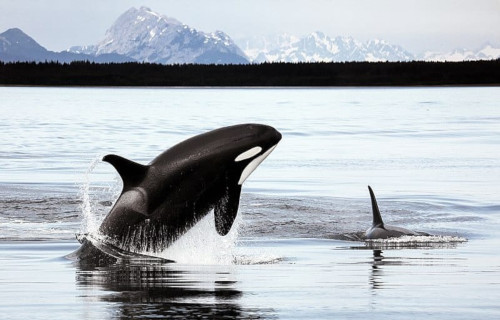
CCL: http://bit.ly/2zDnGC2
Orca Distribution, Habitat, and Ecology
Further augmenting its status, the breathtaking Orca has an extraordinarily broad range of habitation. That’s due to the fact that it inhabits every ocean on earth, from tropical seas to the Arctic and Antarctic areas, and has no known natural predators.
Due to its great range and global distribution, an exact estimate of its numbers is impossible. However, the general estimate is that there are at least 50,000 surviving Orca individuals at this time. But that number could change with new informtion.
Though the species remains present globally, the greatest concentrations exist in higher latitudes and coastal regions. The largest population concentration also lives in the region of Antarctica. This fact often surprises those new to knowledge of it.
Sometimes referred to as the wolves of the sea, the Orca typically hunts in packs. Its favorite prey varies rather greatly, with specialization occurring between local populations. Overall, its food primarily consists of fish, birds, and various marine mammals.
That includes species such as baleen whales, other toothed whales, seals, sea lions, walruses, and at times sea otters. In addition, in the wild, the majority of Orca specimens observed appear to live as long as 90 years. In captivity, sadly, individuals die much younger.
California Sea Lion
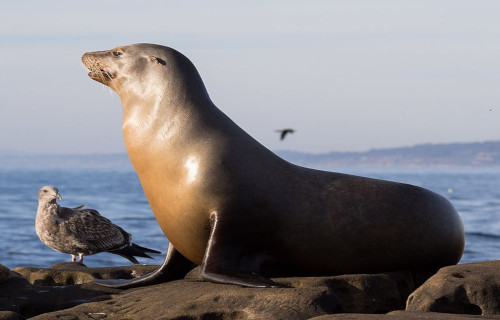
CCL: https://bit.ly/2WpXJkw
California Sea Lion Facts
- The final entry into this compilation of 6 Marine Apex Predators is the amazing animal known as the California Sea Lion.
- Surprisingly, the remarkable creature remains one of only six known surviving types of sea lion. Quite sadly, one other species, the Japanese Sea Lion, became extinct in the 1950’s. In the meantime, three others now rank as Endangered.
- This wonder of Nature also represents the species with the largest current population. In fact, estimates place its total numbers at around 350,000 individuals. Only the South American Sea Lion approaches it in numbers.
- Due to its current population size, along with other factors, the IUCN presently lists the California Sea Lion as Least Concern. Perhaps the leading contributor to its survival success is the fact of its protection under the Marine Mammal Protection Act.
- Like many related species, however, it still faces dangers from various threats. These principally include climate change and habitat loss. In recent years, though, trash and chemical pollutants of the food chain have begun to threaten it.
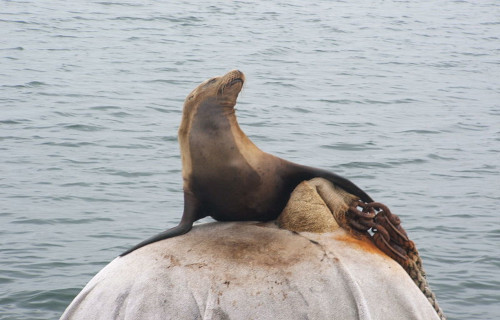
CCL: https://bit.ly/2WpYHxa
California Sea Lion Physical Description
Perhaps most notably, the gorgeous California Sea Lion ranks as one of the smallest of the six surviving species. In addition to this, the animal, like many other similar creatures, exhibits a marked degree of sexual dimorphism.
As a result, males average significantly larger than females. Males attain an average length of about 7.9 ft (2.4 m) and a weight of roughly 770 lb (350 kg). Females average 5.9 ft (1.8 m) in length and only 220 lb (100 kg) in weight. Exceptional individuals do exist, however.
Not only that, but coloring patterns vary between the genders as well. That’s because, like juveniles of both sexes, females typically display a tawny brown coloring. But adult males usually display a darker brown or nearly black color.
While both genders display long narrow muzzles, in contrast, other features of the head and face differ. The males of the California Sea Lion also distinguish themselves by developing a protruding crest with a patch of white hair, and also small manes.
- Kingdom: Animali
- Phylum: Chordata
- Class: Mammalia
- Order: Carnivora
- Family: Otariidae
- Genus: Zalophus
- Species: Z. californianus
Steller Sea Lion Distribution, Habitat, and Ecology
The name of the California Sea Lion remains somewhat deceptive, as its native range extends well beyond the shores of California, in the United States. In actuality, that range extends along the entire west coast of North America. It runs from Alaska to Central Mexico.
The magnificent creation of evolution also inhabits numerous islands in that range, in addition to various locations on the continental shores. Notably among these locations are the Channel Islands, Isla Santa Margarita, and Punta Eugenia.
Like related species, the California Sea Lion evolved to have a carnivorous diet. As a result, the species consumes a relatively wide variety of seafood prey. However, these primarily include small squid, various fish, and occasionally even clams.
Given its size, its own predators quite understandably remain relatively few in number. But a few species do appear to prey on them, most notably large types of shark, including the Great White Shark. Finally, Orcas form its other main natural predator.
6 Marine Apex Predators
We sincerely hope that you have enjoyed reading this article about 6 Marine Apex Predators as much as we enjoyed creating it. These amazing creations of evolutionary processes represent some of the most amazing creatures on the plant.
Unfortunately, many of them, like countless other species, now find themselves facing great threats to their continued existence as a species. It remains up to all of us to do all that we can to protect these species, and preserve them for our posterity.
Check out our other articles on 4 Stupendous Stick Insects, 5 Incredible South American Islands, Earth’s Many Astounding Beetles, Rare North American Flowering Plants

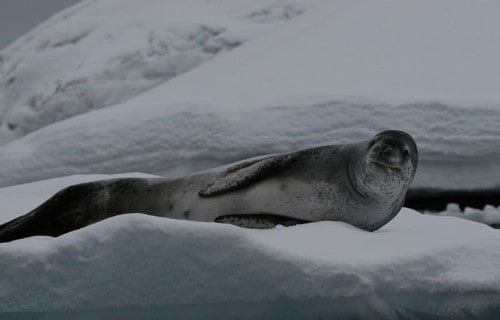
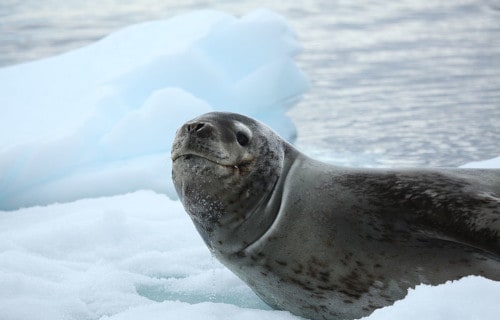
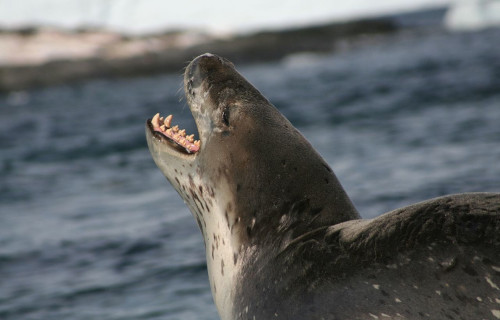
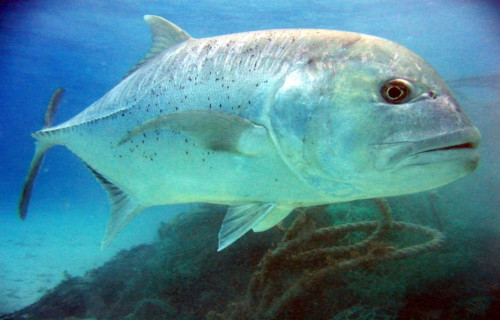
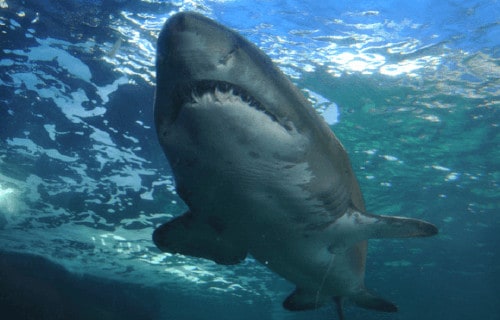
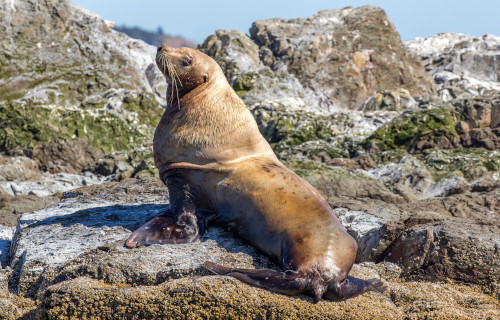









Leave a Reply